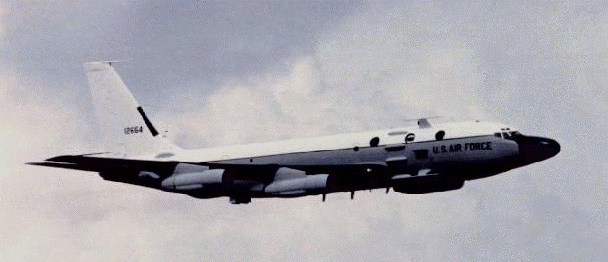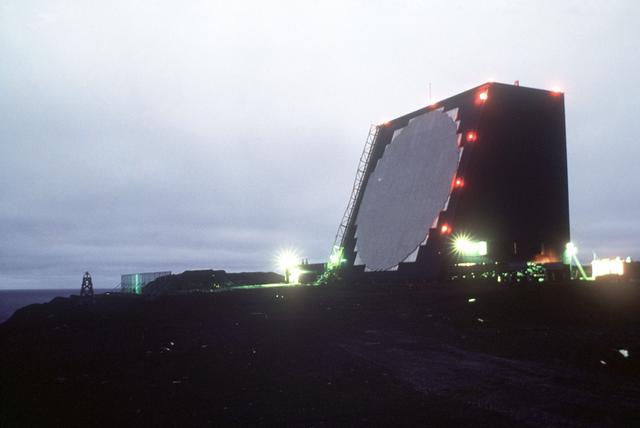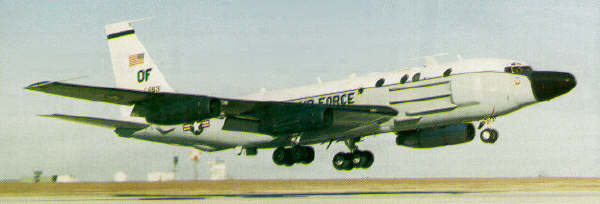Shemya is a wisp of an island along the Aleutian archipelago that is perpetually shrouded in fog and almost always has a 25 knot crosswind from one side or another. Flying a Boeing 707 for the Pacific Air Force (PACAF), we didn't have a lot of support designed to help us out at remote locations like this, so we tended to rely on our sister command, the Military Airlift Command (MAC).
— James Albright

Updated:
2012-08-01
MAC was about as unionized and regulated as we got in the United States Air Force. They had a command structure that was about as airline like as airlines got back then, and rules for everything. Of course, rules were made to be broken. My favorite was . . . "You can't go unless you've been."

Captain Lucky
“Captain Albright,” the scheduler called over the squadron PA, “happy birthday you are twenty-eight years old and you are late for your meeting with the operations officer.”
All eyes in the mission planning room turned to me and my face flushed with the sudden notoriety. Meeting? I double timed down the hallway to Major Bussman’s office, slowed to a military walk, stood at attention and saluted.
Major Bussman returned the salute, ignored my tardiness and handed me a manila folder. “You been to Shemya before?”
“No, sir.”
“Me either. There is a rule about Shemya: you can’t go unless you been. Well, no pilot in this squadron has ever been there so we are stuck. It will be you and I next week. I’m too busy to find out what all the fuss is about, so you do the leg work and I’ll watch you fly.”
“Yes, sir.”
The manila folder had the typical trip sheet information: crew names, passenger data, and itinerary. It was my flight crew minus the copilot, who was on the mainland on vacation. The communications and maintenance team were all familiar too. I didn’t recognize half the security team. In back would be one of our regular teams of Navy passengers probably on some kind of inspection of support facilities for their nuclear submarine fleet. Shemya, I knew, was a postage stamp sized island on the Aleutian Island chain halfway between Alaska and Russia. It was host to an Air Force Base with a reconnaissance unit and some kind of clandestine eavesdropping unit aimed toward the Russian skies.
Our squadron flew four EC-135Js, a Boeing 707 outfitted with communications equipment and passenger seating for the Commander in Chief, Pacific, the highest ranking US military officer for this half of the world. We were a part of the Pacific Air Forces and flew the only large aircraft in the command. As such, we played by our own rules and wouldn’t be constrained by the Military Airlift Command’s “you can’t go unless you’ve been” rule. All the same, these rules usually existed for a good reason and I had to find out what we were up against.
It was 1500 which meant most of the Air Force on the mainland would have left their offices and any phone calls would be a waste of time. I drove across base to the safety office and asked to see whatever they had on Shemya. The result was a single green folder marked “CONFIDENTIAL” and labeled with an ink stamp and hand written entries: 15 MAR 81, RC-135, 61-2664, 6 fatalities, PAEI - PASY. It was the reconnaissance version of the Boeing 707 we were flying on its routine mission to position its crews from their home base, Eielson Air Force Base near Fairbanks, to their deployed location on Shemya Island. The weather was awful, but not bad enough to cause a crash and the loss of 6 crewmembers. The survival story was fascinating. The airplane impacted a hill just short of the runway where World War II anti-tank stanchions remained in place but ended up tearing the airplane apart and hindering rescue efforts. I had to remind myself I wasn’t looking for crash survival hints, but crash avoidance clues.
After an hour of study I came to the same conclusion the Air Force accident investigation board arrived at three years ago. The copilot flew the approach below the radar controller’s glide slope intentionally as part of a misunderstanding of the approach procedure. That placed him and aircraft in an unrecoverable position late in the approach when either a shift in wind direction or speed pushed the airplane further below glide path and right into the hillside. It was exactly as I had been taught at Air Force safety school earlier that year: most aircraft losses are caused by pilots flying perfectly good aircraft into the ground.
The only kind of approach available at Shemya was a PAR, “Precision Approach Radar.” It was the standard instrument approach many years ago, but now it was relegated to the military at obscure locations too remote to have a modern instrument landing system. We flew them routinely from day one in Air Force pilot training and practiced them at least once a quarter. A radar controller paints the aircraft on a scope and gives the pilot heading directions and descent cues. The headings were straight forward: turn left 300 degrees, right 305 degrees, and so on. The descent information was a bit trickier: begin descent, you are on glide path, you are slightly above glide path, you are below glide path, you are well below glide path, and so on.
The worst thing you could hear was “you are too low for safe approach, go around.” That could be the last thing you ever heard. I think I heard that once in the simulator but never in an airplane. In our Boeing 707 we routinely flew these with the landing gear up, the flaps at 30 degrees, and flying an intermediate speed. When the controller said “begin descent” we would extend the landing gear and remainder of the flaps, lower the nose a few degrees and watch the vertical velocity indicator drop to 700 feet per minute rate of descent. TLAR: “That looks about right.” From there on it was a game of adjustment. If you were slightly low, you added a few percent of thrust and increased the pitch a half a degree. TARA: “That Ain’t Right, Adjust.”
The next day after a few phone calls to my contact flying for the Military Airlift Command I had a clearer picture. The weather was fairly constant at Shemya: a 300 foot ceiling, 30 to 35 degrees Fahrenheit, and a stiff crosswind of 25 knots. On the plus side of the ledger, the PAR controllers were the best in the business. In any case, you had to have your “A Game” on to fly the approach successfully.
Still, something was missing. My next call was to the 6th Reconnaissance Squadron at Eielson Air Force Base. There I found out their RC-135s had a lot in common with our EC-135s: same engines, same wing, and about the same weight. That’s when I learned about their “point of no return” ritual.
The point of no return means different things to different aviators, but at Shemya it was all about fuel. Our aircraft’s maximum landing weight was generally around 200,000 lbs. With a typical load of passengers that usually meant we couldn’t land with much more than 40,000 lbs of fuel. That wasn’t enough to miss the approach at Shemya and return to the nearest runway long enough to handle us. So you had to keep enough fuel on the airplane to make it to your alternate until the last minute when you’ve decided the weather at Shemya was good enough. At that point you dumped the excess fuel overboard and you were committed to land at Shemya. You were at the point of no return. Terrific.
The flight from Honolulu to Shemya is just over six hours once you throw in a holding pattern at low altitude just east of the island. We planned one orbit to gauge the weather and another to dump our reserve fuel. We would need forty thousand pounds of fuel to make it to Anchorage plus another ten for reserve. With today’s passenger load, our maximum landing weight would permit only thirty-five thousand pounds of fuel. We had sixty thousand on board.
“Shemya weather,” the radar controller announced, “is one mile, two-fifty overcast, temperature one degree, dew point zero, winds are three-one-zero at forty gusting to fifty.”
Major Bussman fumbled with our squadron in-flight guide. He was looking for the crosswind chart. “That’s twenty-five,” I said, “a thirty degree cross comes to one-half the component.” He was undeterred and continued his task.
“Well captain,” he said as if it was just a routine report, “you’ve got a twenty-five knot cross and everything else is just in limits. Whatcha wanna do?”
“Commence fuel dump,” I said, “ask for the PAR, start the approach checklist.”
I heard the click-click of the interphone system, denoting our hot microphone system in the cockpit was now tied to the rest of the airplane, inviting passengers and crew to listen in on our approach. It was a silly annoyance I could have done without, but that’s the way we did things. I could hear the faint rumble of the hydraulically driven fuel pumps in the body of the aircraft running to push twenty-five thousand pounds of fuel into the cold Aleutian air, that would be almost four thousand gallons.
The PAR controller greeted us and gave us the usual preliminaries. Finally he said, “approaching glide path, wheels should be down.” I gave Major Bussman a thumbs up and inverted my hand to point downward, his signal to extend the landing gear. As the rumble of the air announced our transition I asked for the final notch of flaps. I allowed the landing gear’s drag to overwhelm the changing camber of the wing and held the pressure on the yoke steady. Our VVI, the vertical velocity indicator, crept down to 700 feet per minute, right where I wanted it. “On course,” the controller said, “going slightly below glide path.”
It shouldn’t have been, everything was right out of the text book so far. When in doubt, I knew, do nothing. “On course, going further below glide path.”
Well now I had a problem. The VVI was right at 700, the airspeed was steady, I hadn’t moved the throttles since leaving the holding pattern. “Nav, what’s our ground speed?” We didn’t have a readout for that up front.
“One-oh-five.”
A hundred and five knots? Our approach speed was 147 knots. I pulled the nose up slightly and added a quarter of a knob-width of power on the two inboard engines.
“Turn right two-nine-five,” the controller directed, “now slightly left of course and holding below glide path. Adjust your rate of descent.”
Now this was bad, not only was I low, now I was moving off course and the controller was starting to tell me how to fly the airplane.
“Tighten it up, James.” Now Major Bussman was concerned.
Fifty knots of wind from thirty degrees off runway heading meant a twenty-five knot crosswind. A fifteen degree correction to course made sense. I banked slightly into and out of the turn to watch the heading bug settle on 295. Fifty knots of wind from thirty degrees off runway heading also meant a heck of a lot of headwind. The cosine of 30 is one-half, that’s how I knew the crosswind component without looking it up. What is the sine of 30? Just over point eight? That would make it a 42 or 43 knot headwind. That’s why 700 fpm was too much! In pilot training our first jet, the T-37, made its approaches at right around one-hundred knots. The VVI in that thing was usually about 500.
I raised the pitch further and brought the outboard throttles to match the inboards. The VVI crept up to 200. “Turn left two-nine-zero, correcting to course, correcting to glide path.” I pulled the outboards back an eighth, relaxed some back pressure, and pulled the inboards to match the outboards.
“On course, on glideslope.”
At 300 feet Bussman said “nothing so far,” and then, “oh, it’s to the left. The runway is to your left.”
I looked up and sure enough, the runway was to our left. The strong crosswind meant our nose was a good twenty degrees upwind to maintain course and our first glimpse of it would be to our left. I slid a healthy dose of left rudder and right aileron and landed the aircraft.
We had the next three days off with not much to do. The overcast skies disappeared and it was quite sunny but cold. We Hawaii natives don’t understand how a sunny day cannot be warm. The base wasn’t set up for tourists and didn’t want to spend any extra effort to entertain us. Our passengers, I am sure, got the royal treatment. All this ended for me, however, on day two.
“You Captain Albright,” the lieutenant colonel asked, “you the pilot on that silver and white bird?”
“Yes, sir.”
The colonel introduced himself as the detachment commander and invited the navigator and me, just us two, for a tour of the island. Mark, the nav, declined, saying he wasn’t feeling well. I knew it was a lie, but what the heck. I agreed to go solo.
The RC-135, my host explained, was known as the Cobra Ball. They flew airborne reconnaissance of Russian test missile shots just a few hours east of Shemya. The big radar on the end of the island, Cobra Dane, did the same thing from the ground. Somewhere off the island was a ship known as Cobra Judy. We finished the tour with a look inside the Cobra Ball, an ugly monster of an airplane with all sorts of stuff strapped to its right side for reasons I wasn’t permitted to know. The colonel invited me to sit in the pilot’s seat where I got the nickle tour. It was much like our own aircraft, with a few extra navigation computers thrown in and about half the communications equipment I was used to. It was a good way to waste a day, but I had had enough.
“I noticed an air refueling receptacle on your airplane,” the colonel said before I could climb out of the seat, “are you receiver qualified?” I told him I was. “Instructor?” Yes again. The questions continued: how many hours, what was your commission date, how many years on station in Hawaii, any promotion pass overs, and finally, “How would you like to fly the best mission in the Air Force?”
I politely declined, twice. “We’ll be in touch...” was the last thing he said. “Oh no we won’t,” was my last thought on the matter.
The next week there were orders in my mailbox, I was being transferred to Fairbanks, Alaska to fly Cobra Ball. Shemya would be my new home. Now what?
I thought about options for a day or two and vacillated between fighting the battle or rolling with the punch. On day three the decision was made for me. The squadron’s flight safety officer was leaving for the airlines and the only safety school graduate left was me. A recent spate of airplane crashes pushed the Air Force into requiring every base with flying squadrons have a safety school graduate. I wasn’t going anywhere after all. For now.
“The Albright Luck comes through again!” Other pilots in the squadron now started fretting their own assignments to Alaska, the military personnel center would not be denied. “How can any one person be so consistently lucky?”
When they needed someone for safety school most of these pilots were deep into the woodwork trying to avoid the duty. Getting that on your record was a sure ticket to extra work. How does that saying go? The harder I work the luckier I become.



